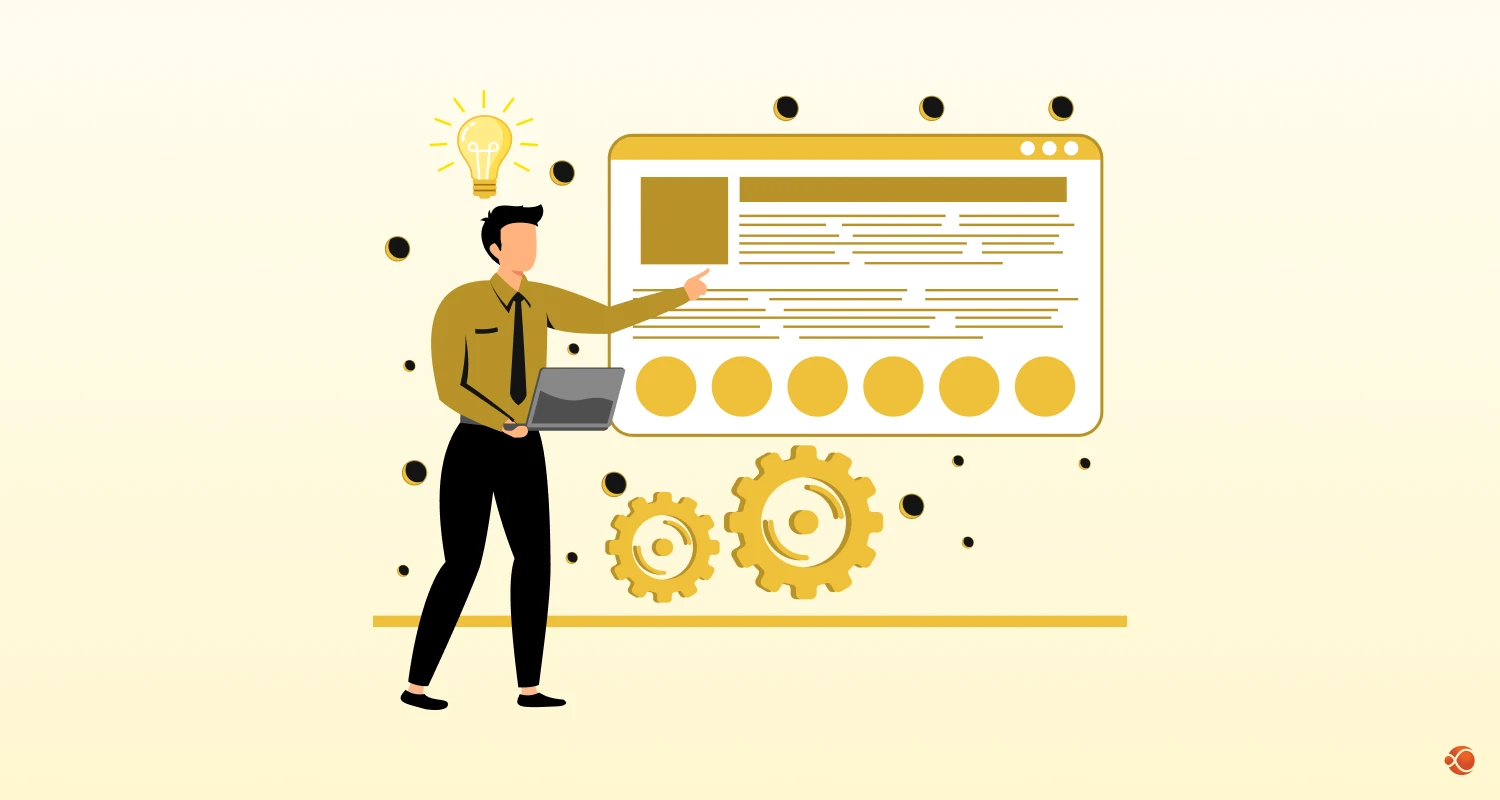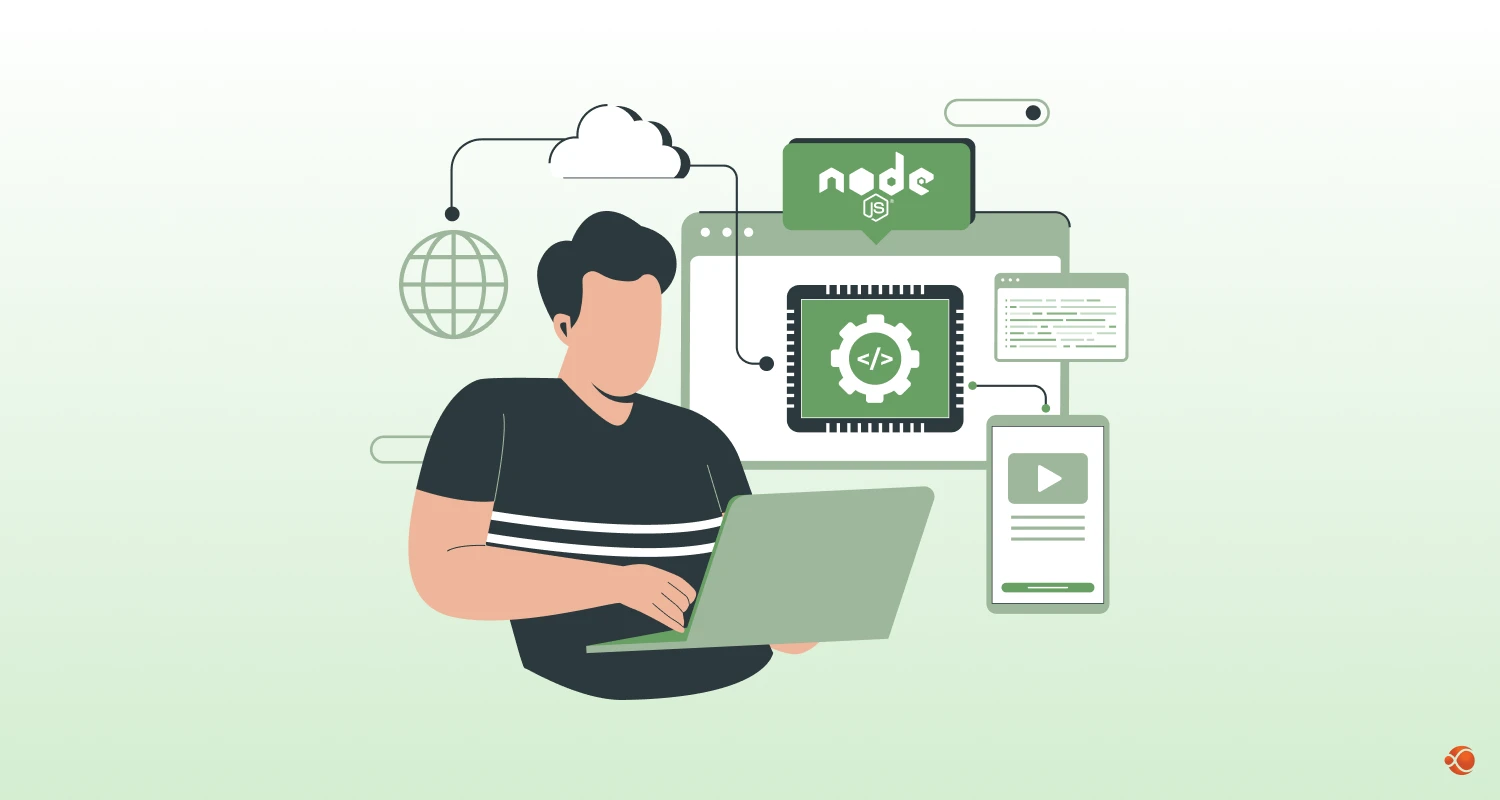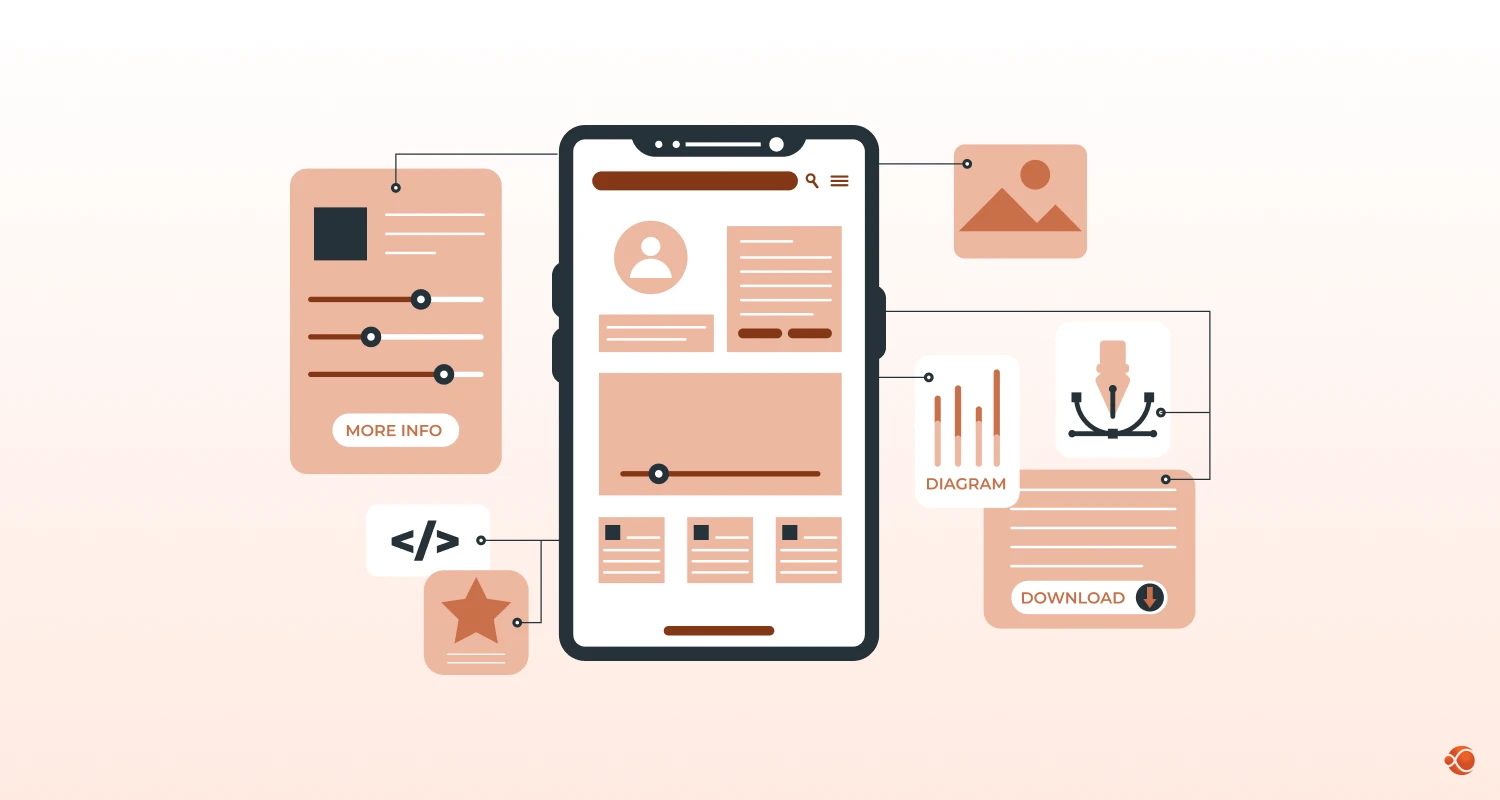Quick Summary: Discover how computer vision in AI is transforming industries by giving machines the ability to “see” and understand the visual world. This guide explores its core technology, diverse applications from self-driving cars to healthcare, and future trends, all while emphasizing its profound impact on business and daily life.
Remember the first time your smartphone instantly recognized your face to unlock? Or when a digital camera automatically focuses on a person in a group shot? These moments might seem like everyday conveniences, but they are actually small glimpses into a massive, transformative technology: computer vision in AI.
Based on market analysis and research, the global AI in computer vision market was valued at $23.42 billion in 2025 and is projected to reach $63.48 billion by 2030, growing at a compound annual growth rate (CAGR) of 22.1% during this period.
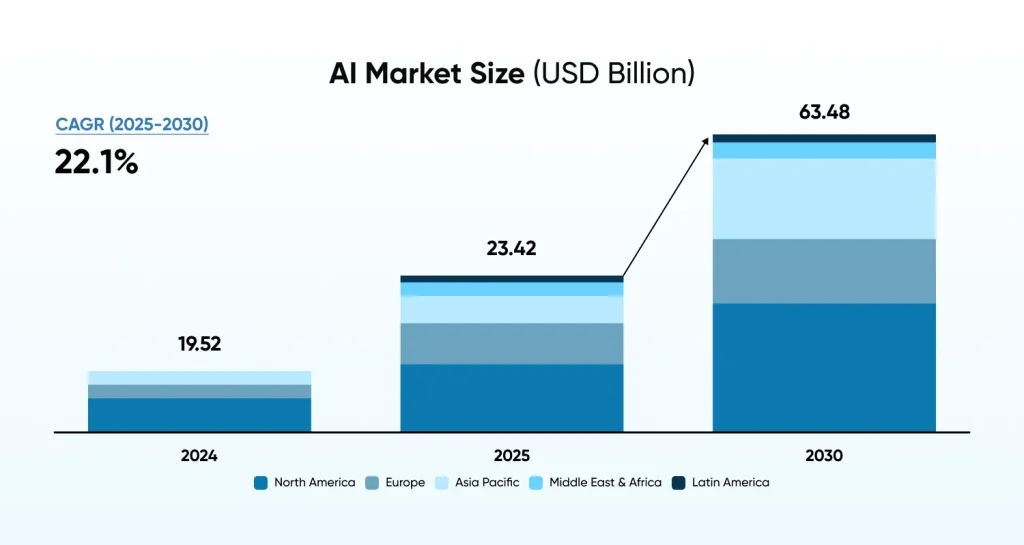
This field is far more than just a neat trick. It’s about giving machines the ability to see and understand the visual world with a level of detail and speed that is reshaping industries, improving safety, and creating entirely new possibilities.
In this guide, we’ll explore the technology behind this revolution. How it works, what makes it so powerful, and the surprising ways it’s changing everything from cars and healthcare to how we interact with the world around us.
What is Computer Vision in AI? An Overview
At its core, computer vision is a field of AI (artificial intelligence) that trains computers to interpret and understand the visual world. Just as we use our eyes and brains to process what we see, computer vision systems use cameras and AI to acquire, process, and analyze visual data from the real world.
The ultimate goal is to allow machines to perform a huge variety of tasks that require visual understanding. Think about a simple action like recognizing a coffee cup. For a human, this is instant and effortless. For a computer, it requires a complex process of breaking down an image into data points and using trained models to identify patterns that match the concept of a “coffee cup.”
These tasks go far beyond simple recognition. They include identifying specific objects, detecting human faces, understanding human actions, and even generating new images. This broad application of computer vision in AI is what makes it so useful. For organizations looking to explore these possibilities, working with AI PoC development services can help validate concepts and demonstrate the technology’s potential before committing to full-scale implementation.
How Does Computer Vision Work?
Journey from a raw image to a machine’s understanding through computer vision is a multi-step process. It’s like how our brains process visual information, but with a series of distinct computational stages.
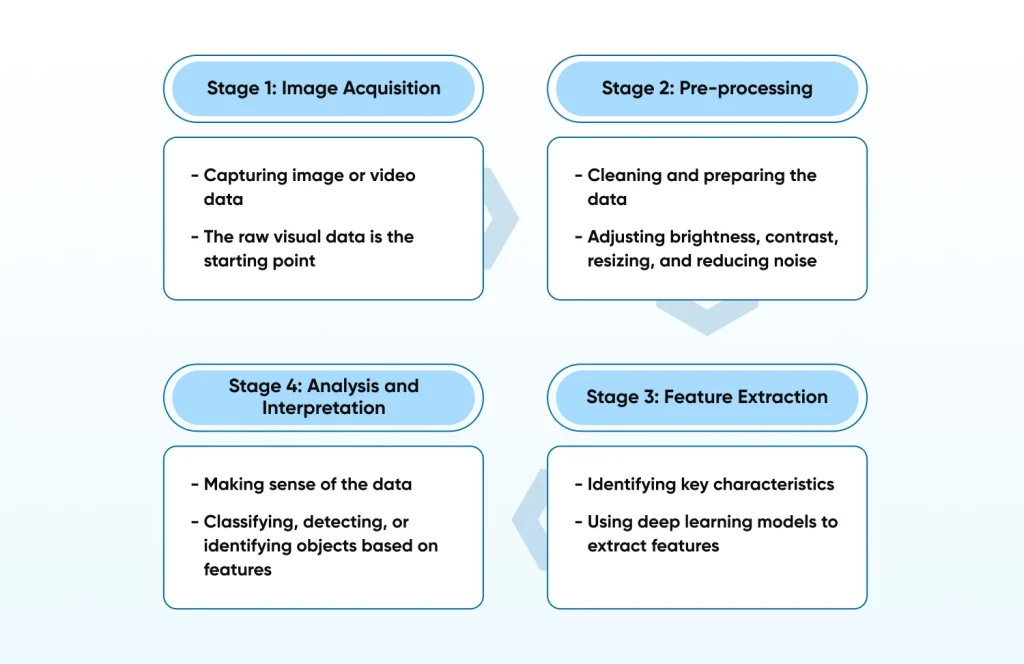
Stage-1 Image Acquisition: Capturing Visual Data
The process begins with a sensor or camera capturing an image or video. This could be a photograph from a smartphone, an image from a medical scanner, or a video stream from a security camera. This raw visual data is the starting point.
Stage-2 Preprocessing: Cleaning and Preparing the Data
Raw images often contain noise, blur, or other imperfections. This step prepares the data for analysis. Preprocessing can involve adjusting brightness and contrast or resizing the image, or reducing noise to improve the quality and make it easier for the model to work with.
Stage-3 Feature Extraction: Identifying Key Characteristics
The system looks for unique features once the image is clean. This could be anything from the edges of a shape to a specific texture or color. Modern techniques often use deep learning models to automatically extract these features, which are far more complex and useful than what older methods could find. These extracted features are what artificial intelligence uses to make its final determination.
Stage-4 Analysis and Interpretation: Making Sense of the Data
This is the last stage where the real “vision” happens. The computer uses a trained model to analyze the features and what they mean. For instance, it might classify the image as a “cat”, detect the location of a “car”, or identify a “detective product” on a factory line. This analysis is where the system makes a decision or provides an output based on its understanding of the visual information.
This is a great example of the many stages and steps required to complete the analysis. An organization that masters this technology can build smarter enterprises with AI by transforming raw visual data into actionable business intelligence.
Which are the Core Technologies Powering Computer Vision?
The incredible progress in computer vision in AI wouldn’t be possible without some key technological breakthroughs. At the heart of most modern computer vision systems are deep learning models, which are a specific type of machine learning.
Machine Learning & Deep Learning: The AI Backbone
Machine learning is a method of instructing computers to learn from data without being clearly programmed. When it comes to computer vision, this means training models on millions of images so they can learn to recognize patterns by themselves.
Deep learning is a step ahead by using multi-layered neural networks. The human brain deeply inspires these networks and is incredibly effective at finding complex patterns in data.
Neural Networks: Especially Convolutional Neural Networks (CNNs)
The star of the show in most modern computer vision systems is the Convolutional Neural Network(CNN). It is a type of deep neural network that is specifically well-suited for processing visual data. It works by passing an image through a series of layers that extract features, from simple ones like edges and colors to highly complex ones like full objects. The impact of AI in computer vision market is expanding at a rapid rate as more companies find new and innovative ways to apply the technology.
Algorithms and Hardware
Beyond the models themselves, a variety of algorithms are used for specific tasks, such as tracking moving objects or recognizing human faces. These algorithms work hand-in-hand with the neural networks to give an accurate output. All of these processing requires significant computational power. This is why specialized hardware, like Graphics Processing Units (GPUs), is important. Graphics Processing Units are designed to handle the complex mathematical calculations that deep learning models require, making them much faster than traditional processors.
For businesses looking to explore these capabilities, working with experienced teams becomes essential. Many organizations hire AI developers who specialize in computer vision to build custom solutions that meet their specific requirements.
Benefits of Computer Vision: Why It Matters
The computer vision is expanding daily, and its benefits are significant. It’s not just about cool technology; it’s about solving real-world problems.
Enhanced Automation
Computer vision allows for the automation of tasks that were prone to human error and were once labor-intensive. In manufacturing, for example, cameras can inspect products for defects at high speed and ensure quality control without the need for manual inspection.
This not just speeds up production but also makes the process more reliable. Understanding the role of AI in digital transformation is important here, as these visual intelligence systems fundamentally change how businesses compete and operate.
Improved Accuracy
Unlike human observers who can get distracted or tired, a machine vision system can provide consistent, high-accuracy analysis 24/7. In fields like medical imaging, this consistency can be lifesaving. A system trained to spot tumors or other abnormalities can do so with a level of precision that can support doctors in making a diagnosis.
Increased Safety
By continuously monitoring environments, computer vision can improve safety. For example, systems can detect if a worker isn’t wearing a hard hat in a construction zone or if an object has fallen onto a conveyor belt. These systems can issue immediate alerts, helping to prevent accidents.
Analyzing a New Type of Data
With its ability to process images and videos at scale, computer vision provides a new way to get insights from visual data. For businesses, this might mean analyzing customer behavior in a retail store to optimize the store’s layout. For scientists, it could involve tracking changes in a forest over time to study the effects of climate change.
Computer Vision Across Industries: Real-World Applications
The true power of computer vision lies in its diverse applications. These computer vision in AI examples are creating smarter, more efficient processes in almost every sector of the global economy.
Automotive: Autonomous Vehicles
The most visible use of computer vision might be in the automotive industry. Self-driving cars rely on computer vision systems to “see” the road, identify other vehicles, pedestrians, and traffic signs, and navigate safely. These systems are also used in advanced driver-assistance systems (ADAS) to help with things like lane departure warnings and automatic emergency braking.
For instance, Tesla’s Autopilot and Full Self-Driving (FSD) systems use computer vision to detect lanes, traffic signs, vehicles, and pedestrians, enabling advanced driver-assistance and semi-autonomous driving features.
Retail: Inventory and Customer Behavior
In retail, computer vision is changing how businesses operate. It can automatically track inventory on shelves and give an alert to staff when an item needs to be restocked. It can also be used to analyze customer movement and behavior in a store, helping retailers understand which products are most popular and how to optimize their layout for sales.
Healthcare: Medical Imaging and Patient Care
Computer vision in healthcare has been a game-changer. Medical imaging, such as MRIs and X-rays, can be analyzed by AI to help in identifying diseases or abnormalities. A system trained on thousands of scans and spot patterns that are not quite visible to the human eye, helping doctors make faster and more accurate diagnoses. Beyond diagnostics, it’s being used for patient monitoring and even for surgical assistance.
Manufacturing: Quality Control
On the factory floor, computer vision cameras are replacing human inspectors. They can accurately and quickly check for defects and make sure that every product meets the strict quality standards. This is faster and more reliable than a human doing the same job, and it prevents faulty products from reaching consumers.
Agriculture: Precision Farming
In agriculture, computer vision helps farmers operate it more efficiently. Drones equipped with cameras can monitor crops for signs of disease or pest infestations, so that farmers can take action before a crop is lost. It can also guide automated machinery to crop fields or harvest produce, reducing the need for manual labor.
Future Trends of Computer Vision in AI
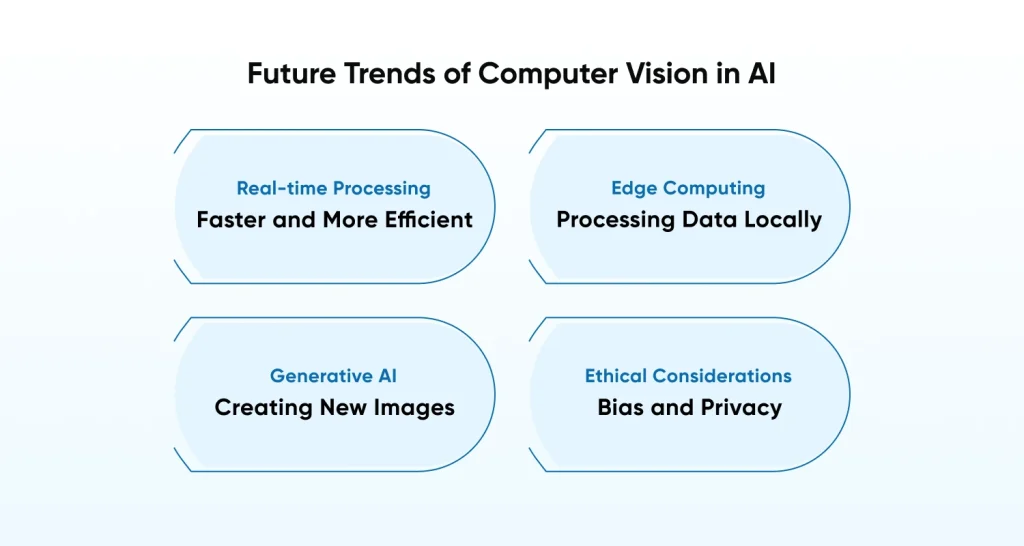
The progress of computer vision in AI is not slowing down. The technology is continuously evolving at a fast pace, with new trends on the horizon that will continue to unlock new possibilities.
Real-time Processing: Faster and More Efficient
The ability to process visual data in real-time is a key focus for the future. Systems will be able to interpret live video streams with almost no delay, allowing for more dynamic and immediate applications. This is important for everything from live sports analysis to urban traffic management.
Edge Computing: Processing Data Locally
Currently, many AI systems send data to the cloud for processing, which can cause delays. Edge computing includes processing data directly on the device where it is captured, such as a camera or a drone. This will lead to faster response times, better privacy, and reduced reliance on internet connectivity. The growth of agentic AI in computer vision is also a fascinating development, where models can perform complex tasks autonomously, making decisions and taking actions based on their visual understanding.
Generative AI: Creating New Images
Generative AI, like the models that can make realistic images from text prompts, is a powerful new area. These models not only understand images; they can create them. Generative AI models have applications in fields like art, design, and even in generating data to train other AI models.
Ethical Considerations: Bias and Privacy
As computer vision in AI becomes more widespread, it’s important to address the ethical challenges. Issues like bias in facial recognition algorithms and privacy concerns related to constant surveillance need to be carefully considered. Ensuring these technologies are developed and used responsibly is a major focus for researchers and policymakers.
Why Choose CMARIX for Your Computer Vision Projects
When it comes to implementing computer vision solutions, choosing the right development company can make a huge difference. CMARIX stands out as a leading technology company for businesses looking to harness the power of computer vision in AI.
Deep Technical Expertise
CMARIX has a team of experienced AI engineers and computer vision specialists offering deep technical expertise to make sure your project succeeds from concept to deployment.
End-to-End Development Services
We provide comprehensive AI software development services covering all the aspects of your project, from initial analysis and model training to full-scale deployment and maintenance.
Industry-Specific Solutions
Our industry-specific expertise in sectors like manufacturing, healthcare, and retail allows us to develop tailored solutions that are both commercially viable and technically sound.
Collaborative Approach
We work closely with our clients through a collaborative approach to ensure the final solution perfectly aligns with their business objectives and expectations.
Final Words
Computer vision in AI is reshaping how we interact with technology. From medical diagnostics to autonomous vehicles, these systems are delivering new levels of automation and precision that seemed impossible just a few years ago.
AI surveillance software development represents just one facet of this broader transformation. As computer vision becomes faster and more accessible, we’re seeing it woven into security systems, smart cities, and countless other applications that make our world more responsive to what’s happening around us.
FAQs on Computer Vision in AI
Why Is Computer Vision Important in AI?
It’s crucial because it gives machines the ability to interpret and understand visual information, bridging the gap between the physical world and digital systems. This makes AI more versatile and applicable to real-world problems.
What Are the Uses of AI in Computer Vision?
Applications are numerous and span many industries. Examples include medical image analysis in healthcare, object detection for autonomous vehicles, quality control in manufacturing, and inventory management in retail.
How Do Industries Measure ROI or Cost Savings With Computer Vision?
ROI is measured through key metrics like reduced defect rates, decreased inspection time, and lower labor costs in manufacturing. Other examples include improved diagnostic accuracy in healthcare and reduced theft in retail, typically showing returns within 12-24 months.
Which Is an Example of Computer Vision in AI?
A common example is facial recognition technology used in smartphones. The system captures your facial image, uses neural networks to identify unique features, and compares it to stored data to verify your identity, all within milliseconds.
Is Computer Vision the Same as Generative AI?
No, they are different but related. Computer vision analyzes and understands existing visual content, while generative AI creates new content from scratch. They can work together, for example, with generative AI, creating training images for computer vision models.





